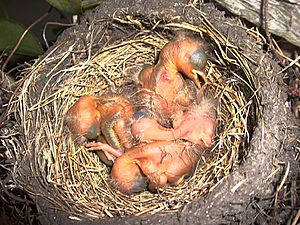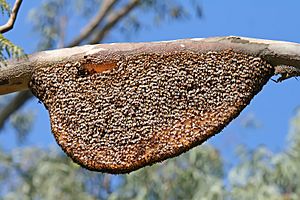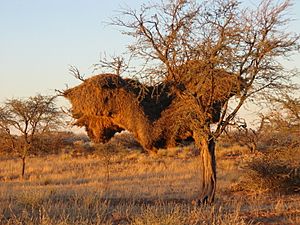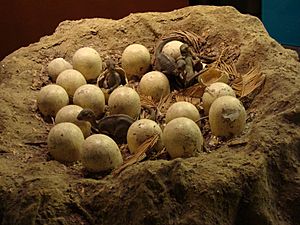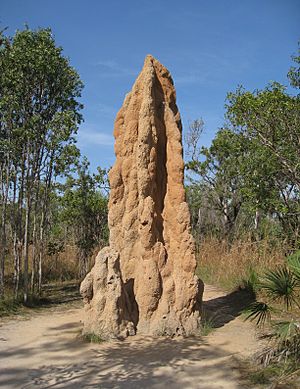Nest facts for kids
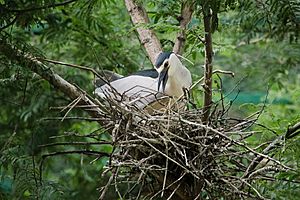
A nest is a special home built by animals. They use nests to hold their eggs or to raise their babies. While birds are famous for nests, many other animals with backbones (called vertebrates) build them too.
Nests are often made from natural things like twigs, grass, and leaves. They can also be a simple dip in the ground, or a hole in a rock, tree, or even a building. You can find nests in almost every type of habitat on Earth.
Contents
Why Animals Build Nests
Animals build nests for important reasons, mostly to keep their young safe. This urge to build a safe place for babies is sometimes called the "nesting instinct."
Protecting Eggs and Babies
Nests help protect eggs and young animals from danger. They can hide eggs from predators (animals that hunt others) or shield them from harsh weather like too much sun. Some nests simply keep eggs from floating away in ocean currents. For animals that lay many eggs, nests can also offer safety in numbers.

Raising Young and Social Life
Many animals that build nests also take care of their young. For example, birds often sit on their eggs to keep them warm, a process called brooding. Generally, the more care parents give, the more complex their nests are.
Building nests can also help animals live together in larger groups. This means more animals can live in a smaller area, increasing the number of creatures an environment can support. Insects that build the most complex nests, like ants and termites, also have very organized social lives.
How Animals Build Nests
Animals build nests in two main ways: by sculpting or by assembling.
Sculpting Nests
Sculpting means removing material to create a nest. This usually involves digging into the ground or into plants to make a cozy spot.
Assembling Nests
Assembly means gathering, moving, and arranging materials to build a new structure. Moving materials takes a lot of time and energy, so animals usually build with things they can find nearby.
Building Materials
Plant matter is the most common material for nests. Other popular materials include fur or feathers (sometimes from the animal itself), mud or dirt, animal waste, and special liquids (called secretions) from the animal's body.
Impact of Nests on the Environment
Nest building can really change the environment. For example, the combined digging of termites and mole-rats in South Africa has created a unique landscape with huge flat areas dotted with large mounds. Similar mounds are made by pocket gophers in the United States and rodents in Argentina.
Some nests built by megapode birds are so tall (up to 10 meters or 33 feet) and numerous that people have sometimes mistaken them for ancient human structures!
Who Builds Nests?
The way an animal builds its nest can be as unique as its physical appearance. Sometimes, scientists can even tell different species apart just by looking at their nests. This is common with wasps, termites, and some birds.
Most nest builders don't have special body parts just for building. Instead, they use body parts that are mainly for other things, like their beaks, paws, or mouths.
Birds
Birds are often seen as the best nest builders. However, not all birds build nests; some lay their eggs directly on rocks or bare ground. Complex nest building helps birds survive by keeping their eggs and young safe from predators and bad weather. This increases the chance that baby birds will grow up.
Bird nests vary a lot. They can be simple dips in the ground (called scrapes), loose piles of branches, or very detailed woven hanging nests. Megapodes, for example, don't sit on their eggs. Instead, they bury them in mounds of rotting plants that create heat. One species, Macrocephalon maleo, even uses volcanic sand warmed by the Earth's heat!
Simple nest builders include falcons, owls, and many shorebirds. The weavers build some of the most amazing nests, tying grass strands into knots. Most bird nests are somewhere in the middle, often cup-shaped and made from mud, twigs, leaves, and feathers. Some birds, like flamingos and swifts, use their saliva to hold their nests together. The edible-nest swiftlet uses only saliva! The rufous hornero builds a nest entirely from mud and animal waste on tree branches, letting the sun harden it. Tailorbirds sew leaves together to hide their nests.
The sociable weaver builds huge shared nests where many individual nests are found. They divide the nest with grass walls on a base of large sticks. Sharp sticks are placed at the entrances to keep out unwanted visitors. A single shared nest can be 2 meters (6.6 feet) tall and 8 meters (26 feet) wide, housing up to 300 pairs of birds! Other birds sometimes build their own nests on top of these large weaver nests.
Some birds build nests in trees, while others like vultures, eagles, and many seabirds build on rocky ledges. Some nest on the ground or in burrows. Each bird species has its own nest style, but they usually choose the safest spot available. Some birds, like the bushtit and Bullock's oriole, hang their nests from the tips of thin branches. Oropendolas take this to an extreme, building hanging pouches up to 1.8 meters (5.9 feet) tall using vines. This helps protect them from predators. Other birds look for cracks, using buildings or birdhouses if tree holes are not available.
Bird nests can range from 2 centimeters (0.8 inches) for hummingbirds to 2 meters (6.6 feet) in diameter for eagles. The largest bird nest ever recorded was made by bald eagles. It was 2.9 meters (9.5 feet) wide, 6 meters (20 feet) deep, and weighed over 2 metric tons (4,400 pounds)! The lightest nests might weigh only a few grams. The incubation mounds of the mallee fowl can be 4.57 meters (15 feet) tall and 10.6 meters (35 feet) wide, using an estimated 300 metric tons (660,000 pounds) of material!
Mammals
Many small mammals like rodents, rabbits, and ground squirrels dig burrows in the ground to protect themselves and their young. Prairie dogs build amazing tunnel systems that can cover huge areas. One "town" was so big it covered 25,000 square miles (65,000 square kilometers) and held about 400 million prairie dogs! Their homes are built to handle big temperature changes, floods, and fires. Young prairie dogs are raised in the deepest parts where the temperature stays steady.
Many mammals, including raccoons and skunks, find natural holes in the ground or trees for their nests. Raccoons and other rodents use leaves to build nests underground and in trees. Tree squirrels build their nests (called dreys) in trees, while voles nest in tall grass. For some species, the nest is a home for adults, while for others, it's just for raising young. The duck-billed platypus and the echidna actually lay eggs in nests!
Gorillas build fresh nests every day from leaves and plants to sleep in at night. They sometimes build nests during the day for resting too. Smaller gorilla species build their nests in trees, but larger ones stay on the ground. Nests of the western gorilla, the biggest species, are about 1 meter (3.3 feet) wide.
Amphibians
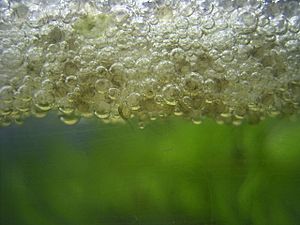
Some frog species build nests that range from simple to somewhat complex. Many frogs that live in streams lay their eggs in a jelly-like mass, which they attach to plants underwater. This jelly keeps the eggs from being washed away.
Fish
Fish also build nests! Their activities range from simply scooping out sand to building enclosed structures from plants. Male sticklebacks even produce a special glue from their kidneys to stick plants together.
Reptiles
The American Alligator is known for being a good parent. Females build large nests of mud and plants on riverbanks. The female digs a hole in the center to lay her eggs, covers them, and then guards them for two months until they hatch. When the eggs start to hatch, she breaks open the hardened nest and leads her young to the water, where she continues to care for them for another year. Alligators are very particular about their nesting spots and will leave a site if things go wrong.
Cobras use leaves and other plant bits to build nests where they lay eggs. Both male and female cobras guard the eggs. They carry plants to the nest by bending their necks. Sea turtles dig a hole in the sand above the high tide line to lay their soft eggs. They then cover the eggs to protect them from the sun and predators, and then leave.
Dinosaurs
From fossils, we know that many, or perhaps all, dinosaurs laid eggs. Scientists can tell a nesting site from just a random group of eggs by looking for things like regular patterns of eggs, whole eggs found with broken ones or baby dinosaurs, and signs of digging.
The Oviraptor nests found in Mongolia are very famous. One fossil showed an Oviraptor sitting on a nest as if it were keeping the eggs warm. This proved that the animal had been wrongly named (Oviraptor means "egg taker").
A place called Egg Mountain in Montana has amazing proof of dinosaur nesting. It has dozens of nests, each with 20 or more eggs belonging to the Maiasaura. Young dinosaur teeth found there show signs of wear, but their leg bones were not strong enough for walking. This led scientists to believe that Maiasaura provided a lot of parental care for its young. It's thought they covered their nests with sand and plants to keep them warm and nested in groups for better protection.
Insects
Social insects, like most species of ants, bees, termites, and wasps, are nest builders. Their often complex nests can be above or below ground. These nests often have air systems and separate rooms for the queen, her eggs, and developing young.
Bees and hornets often find natural holes to build their nests, also known as hives. They store food and raise their young there. Other bee species and some wasps dig holes in the ground or chew through wood. For example, the female Megachile rotundata bee builds tube-shaped nests in rotting wood or small holes, making each cell from circular pieces of leaves cut with her mouthparts. Bee nests are built from wax they make, while wasp nests are made from plant fibers they chew and mix with saliva to make paper-like material. Nests often have different areas for eggs and food. Vespid wasps build complex paper nests where they lay eggs in individual cells. When the young hatch, their parents feed them chewed-up larvae. Different species have different nest structures. Paper wasp nests have one layer of cells, while yellow jacket nests can have many layers, up to 30 centimeters (12 inches) wide. Nesting strategies can change based on the environment. For instance, the wasp Parischnogaster mellyi changes its nest building a lot depending on conditions. Nest sizes vary greatly; the largest wasp nest ever found was 1.75 meters (5.7 feet) wide and 3.7 meters (12 feet) tall, likely built by the German wasp in New Zealand.
Termites build complex nests that can last for decades and house many generations. Using chewed wood, mud, and animal waste, they build large mounds that can reach high into the air. The biggest nests, built by Amitermes termites, are nearly 7 meters (23 feet) tall with a similar width at the bottom, and can hold millions of termites! Termite mounds are built to have excellent airflow, which helps control the temperature inside. These mounds protect them from drying out and from predators, allowing many species to lose old traits like hard bodies or good eyesight. Magnetic termites build their nests with flat sides facing north-south. This helps them get maximum warmth in winter and avoid too much sun in the middle of the day. Other termite species use their nests to grow fungi for food.
Ant nests have a complex colony structure that can go 2 meters (6.6 feet) or more underground. As the structure goes deeper, the individual rooms get farther apart, suggesting the ants know how deep they are. Scientists think they might do this by sensing the amount of carbon dioxide in the soil. The leaf cutter ant builds a complex nest that can house 8 million ants! Its nests have many rooms, especially "garden chambers" where they grow fungus on leaves they collect from the forest.
Some species, like the carpenter ant and the wasp Polistes exclamans, build "satellite nests." These are smaller nests near, but separate from, the main nest. They act as a backup against predators and parasites. If the main nest is attacked, surviving members can move to the satellite nest. Other species, like the Black hover wasp, Parischnogaster alternata, build nests in clusters, with older colonies in the center surrounded by younger ones.
The Eastern carpenter bee, Xylocopa virginica, is unique because it builds its nests in wood, bamboo, agave stalks, and similar materials, preferring pine or cedar wood. When digging nests, they use wood shavings to create walls within the tunnels. The nests are usually round and have 1-4 tunnels, each with multiple branches. Since these materials are often used by humans for building, X. virginica's nesting can weaken wooden structures.
Nests and Other Species
The many living things found inside nests attract specialized predators. The aardvark and the anteater use their long tongues to eat termites and ants from their nests. Birds like the European honey buzzard specialize in eating wasp and bee nests, a food source also targeted by the tropical hornet. Many other animals live in nests with the builders, sometimes just eating waste, or sometimes being parasites. Ant nests alone support many different types of arthropods, including 35 families of beetles!
Names of Nests
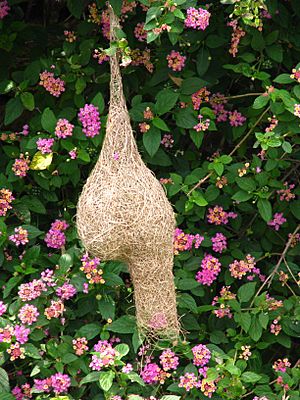
- A badger's nest is called a sett.
- A beaver's nest is called a lodge.
- An eagle's nest is called an eyrie.
- A pheasant's nest is called a nide.
- A rabbit's nest is called a form.
- A squirrel's or ringtail possum's nest is called a drey.
- A wasp's nest is called a vespiary.
Images for kids
-
Bornean orangutan (Pongo pygmaeus) in its nest.
See also
 In Spanish: Nido para niños
In Spanish: Nido para niños


